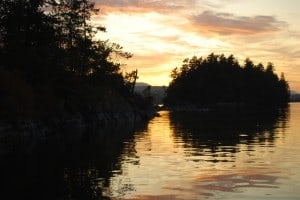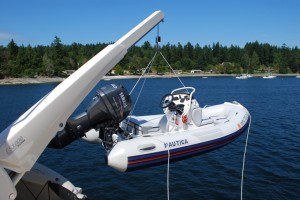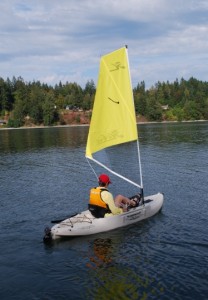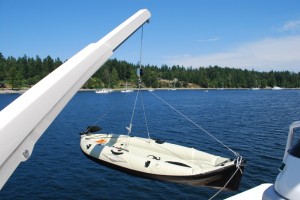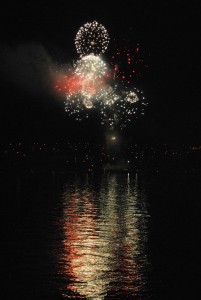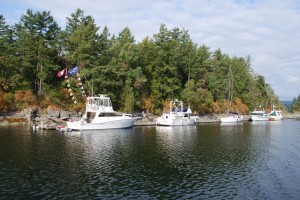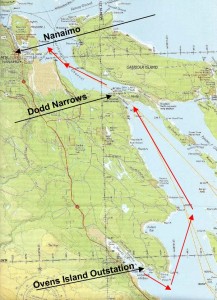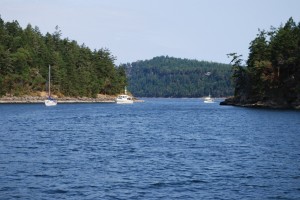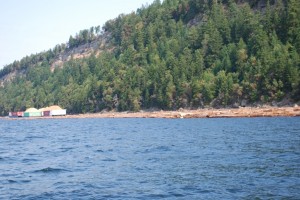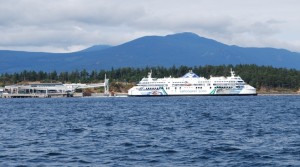Hello all,
Wednesday, July 28 – Sidney, B.C. to Ovens Island SYC Outstation (Ladysmith Harbour on Vancouver Island)
By Wednesday, July 28th, we’d been in Sidney for eight days, the coolant leak on the port engine was fixed, and we’d provisioned with enough meat and perishables for several weeks. There wasn’t any reason to hang around. Our friends, Steve and Shirley Clark, had suddenly arrived on Monday afternoon and were moored at their slip down the dock from us – they weren’t expected until Wednesday and we’d figured we’d miss them. Steve cooked great baked scampi dinner on the Couverden on Monday night and we got caught up on all the news in their world. We didn’t have any reason to hang around, and interesting cruising spots to the north were beckoning.
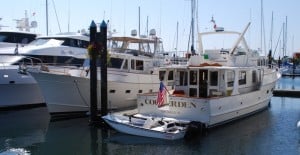
Golden Marlin II - owned by Frank (Bamboo) Opperman of Honolulu - on the left; Couverden - owned by Pinkie Stolz of Port Angeles, WA, and skippered by her daughter Shirley and son-in-law Steve Clark - on the right.
Click on any image to see an enlarged view.
After a leisurely morning getting Flying Colours ready to go, Kap backed us out of our slip at 10:15AM. It was already quite warm, with just a hint of a cool breeze blowing across the water as we waved our last goodbyes to Bamboo (Frank Opperman) of Golden Marlin II and Shirley (aka Andrea) and Steve Clark on Couverden. Kap pointed us towards the breakwater exit to Port Sidney Marina and we felt really good to finally be on our way north.
Kap had selected our course and plotted it with the Nobeltec chart plotter software on the Flying Colours navigation computer. The overall plan was to head for Ovens Island – a tiny private island owned by the Seattle Yacht Club near the entrance to Ladysmith Harbour on Vancouver Island. It was a 31 nautical mile cruise (a nautical mile is 1.17 statute miles, so this would be just over 36 statute miles). To get there, you have to go on either side of Saltspring Island directly north of Sidney, and the shortest (and most interesting) route is up the west side of Saltspring, through Sansum Narrows and into Stuart Channel. (Normally, we go the longer route up the east side of Saltspring as we usually call in at Ganges for our wine provisioning – since we did that by car last weekend there was no need for that stop.)
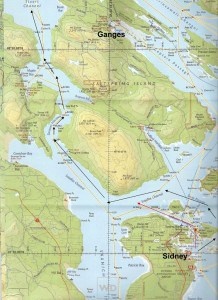
Our route from Sidney to Ovens Island took us up the "backside" - or west side - of Saltspring Island, through Sansum Narrows, and into Stuart Channel. This is the faster route, particularly when we didn't need to call in at Ganges.
Leaving the Sidney area there are several navigational choices to make – how to get around or through a cluster of islands off the NE tip of Saanich Peninsula to get to Satellite Channel at the south end of Saltspring Island. There are charted passages through the islands, but each presents some challenges with shoals and dangerous rocks at low tide – and when we left Sidney it was midway on a lowering tide, giving us a current against us (and Sunday was a full moon, so it would be a relatively strong current). As a shortcut, Kap was hoping to take John Passage, between Coal and Goudge Islands, leading to Colburne Passage – using a set of GPS waypoints that have been perfected and published by Don and Réanne Douglass in their San Juan and Gulf Islands books. Navigation has to be precise through here to safely pass, and with the current Kap didn’t feel comfortable. She thought that Shirley Clark on Couverden uses this shortcut, so before we departed she stopped by Couverden to get her advice. As it turned out, Shirley doesn’t use John Pass, but rather the even shallower and trickier Iroquois Passage on the west side of Goudge Island, having been shown that route many times by her late father, and she has her course carefully laid out on paper charts (Couverden doesn’t use electronic chart software, relying instead on paper charts). At the last minute, Kap decided to take the tried and true route up the east side of Coal Island, then Shute Passage and into Satellite Channel. It probably added 2-3 miles to our route, but the difference in cost if we ran aground on the rocks would be tens of thousands of dollars – a no brainer!
As we turned northward on Satellite Channel towards the west side of Saltspring Island we were surprised at the high cruising speed of the boats we met and were passed by. Two years ago – at the height of the global financial crisis – cruising speeds were down in the 8-9 knot range. Now, though, Bayliner-type cruisers (i.e., planing type hulls) were zipping by us at 15-18 knots. We felt this was a sure sign of the economy – people must feel it’s on the upswing, and now they have money to burn (and the corollary is, they don’t give a damn about burning huge amounts of fossil fuels). Fuel prices are still quite high – we paid $3.17/gal for diesel when we left Anacortes, compared to over $5.00/gallon in 2008 when we went to SE Alaska. We prefer to cruise at 8-9kts, at about 1,300 RPM, and at that RPM we’re burning 8-10 gallons of diesel per hour (combined on both engines) – or about $30/hour fuel cost. The boats passing us at 15-18 knots are probably burning 25-30 gallons per hour (which works out to almost $100/hour fuel cost. For us, that just doesn’t make sense – we enjoy the scenery more at 8-9 knots, and it’s easier (and less stressful) to spot hazards in the water – crab and shrimp pots, deadheads, and logs and debris floating in the water. Unfortunately, there are a lot of inconsiderate people on the water, passing close by and not caring about their wake, and just not caring about the “rules of the road”. Our training in that area (thank you, Linda Lewis!) has been very valuable for us in that respect.
Sansum Narrows is always a nice cruising route. It’s wide enough that currents during ebb and flood are mild – generally not more than 1-2 knots. It’s also wide enough that meeting and passing other cruisers is easy, making it a pleasant route in fine weather. The mountains on Saltspring Island rise almost directly out of the water, with fairly gentle slopes that reach 2,000’ on the three peaks that you pass. On the Vancouver Island side you pass Cowichan Bay, which has the aptly-named and touristy town of Cowichan Bay on the south side, and on the north side is another bay – Genoa Bay – with its very quaint Genoa Bay Marina where we spent several days last year with Flying Colours.

Last year when we called in at Maple Bay Marina, we were docked close to the Taconite, the 125' custom yacht built by William Boeing in 1930 (when The Boeing Company was still quite young). The Boeing family cruised each summer along the Inside Passage, and it was in 1956 on a return from their summer cruise that Boeing died aboard the Taconite just before she berthed at her Seattle Yacht Club moorage.
Just beyond the north end of Sansum Narrows is Maple Bay, with the town of Maple Bay clearly visible as you cruise by. We spent several days at Maple Bay Marina last year and really enjoyed it. Just outside Maple Bay is a stately old manor-type hotel called Cowichan Bay Inn, and we had an absolutely wonderful dinner there.
From there the cruise northward is through Stuart Channel, at about two miles wide, passing the small town of Chemainus on your port side, and Kuper and Thetis islands to your starboard. We spent several days at Telegraph Cove Marina on Thetis Island last year on Flying Colours during our shakedown cruise. A short walk from the marina you can catch the ferry as a foot passenger across to Chemainus on Vancouver Island. Chemainus has become quite a tourist attraction – maybe one of the largest on Vancouver Island. Once a bustling logging town, it almost went out of existence when the mill closed. In the 1980s, an artist group painted 39 murals on the front and sides of town businesses, and community action encouraged people to spruce up their houses and shops. During the summer, the town is now packed with tourists from all over North America. According to the website, www.dive.bc.ca, an out-of-service Boeing 737-200 was sunk in 2006 off the waters of Chemainus to create an artificial reef for marine life and for divers to explore. The website has photos of the sinking, plus a map that shows the aircraft in 90’ of water on a sandy bottom.
Arriving at Ovens Island
We ran our watermaker throughout the cruise to ensure we had full fresh water tanks on arrival at Ovens Island – the island doesn’t have electrical power or fresh water – so you need to be self-sufficient.
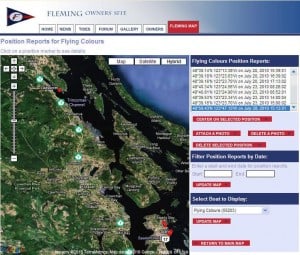
This screen shot from the Fleming Owner's Forum and web site is a Google Map that shows Flying Colours at Sidney (lower right red dot), and at Ovens Island (red dot upper left corner).
The Seattle Yacht Club owns tiny Ovens Island island just inside Ladysmith Harbour – named after Wallace Ovens who purchased the island in 1965 and donated it to the SYC as a gift. The outstation is located in Sibell Bay, on the north shore of the most easterly of the Dunsmuir Island Group. (Unfortunately, the SPOT Current Location pin positions only last for a few days, so if you’re reading this right after our arrival on July 28, click on the Current Location tab at the top right corner of the blog home page – otherwise, I’ve captured a screen shot of our location from the Fleming Owner’s web site.
Here’s what our SYC outstation handbook says of it: “This outstation has retained its natural setting and original rustic charm in the very heart of Canada’s busy Gulf Islands. The entire secluded island is only 200’ by 800’, and you can walk the rough trail that encircles it in about 20 minutes, with scenic outlooks that have picnic tables and benches”
And for us it’s a great place to walk the dogs and cat. There are 450’ of first class floats to tie up SYC member boats, which isn’t very much compared to other SYC outstations, but this is usually plenty of dock space. Of the 11 outstations owned by the SYC, this one is our favorite, as it’s the least-used – mainly because it’s the most primitive and without facilities. Frequently there are only one or two boats here, and often we’re the only boat – we really like the solitude of that. In the past, we’ve been here mostly in late August and September, and by then many of the cruisers from SYC have headed south for home.
At the end of July – particularly during the long Canadian weekend holiday for B.C. Day – we expected even Ovens Island to be full, and maybe we’d have to anchor in Sibell Bay the first night, then move onto the dock when some boats left the following morning. On arrival, though, there were only two SYC boats tied up at the dock – a sailboat at one end and a power boat at the other end. We immediately recognized the powerboat as the Night Wind, a Master 51’ owned by Jim and Molly Ferguson (one of four other Ferguson’s in the SYC). We’ve met them here several times before, as they too like Ovens Island the best of the outstations. We didn’t meet the couple in the sailboat, as they kept to themselves at the other end of the dock. Both departed the next morning, and we had the place all to ourselves. As soon as Night Wind was out of sight, we loosened our dock lines and moved Flying Colours to the west end of the dock, where we had an unobstructed sunset view. At this time of year, sunsets at Ovens Island are spectacular.
One annoying problem with Ovens Island is the raccoons. A family lives on the island (we’ve heard there are as many as 11, and right now there are at least three baby raccoons as well), and with no fresh water sources on land, they board every boat at the dock repeatedly throughout the night, licking up the dew that forms on any surface. They have dirty muddy feet, and they track it all over the boat. One night, Kap looked up through the glass hatches above our main stateroom berth and saw one of them peering in at her. It’s quite unnerving to hear them walking around on your boat all night long. They pull mussels from under the dock floats, opening the shells on the dock and leaving cracked bits of shell all over the place as they dine. Worse, they poop all over the dock, and it’s not nice to clean up. The SYC outstation caretaker has tried trapping them, but this hasn’t worked as they retreat to one of the other islands at low tide when there are exposed rocks between the islands.
Late Friday afternoon, five additional boats arrived – two of them cruising together – and we went out to help them secure lines at the dock. They had barely stepped off the boat when one woman said, “Let’s have a Green Box at 5PM.” We all thought it was a great idea.
The “green box” is an SYC tradition – so named after the green equipment box on the dock at the Port Madison outstation (across Puget Sound from Seattle) that became the gathering place for an afternoon social. Now at all outstations, all someone has to do is say, “Let’s have a Green Box”, and it’s on. At the appointed hour, everyone brings their favorite appetizer to share, and whatever libation they care to drink. With a club of 3,000 members, this gives everyone some really good opportunities to get to know everyone else and to socialize about the day’s cruising. Being relatively new to the SYC (we joined in 2007), we don’t know many other cruisers, so this is great for us. We get to hear what others are doing, and exchange tips on where to go, and where not to go. Unfortunately, the appetizers are rather bad (most people bring chips or crackers and a dip), so being the Galley Master on Flying Colours, I go out of my way to bring something I’ve spent a fair amount of time on – baked stuffed mushrooms, or a bruschetta under the broiler with an artichoke and caper topping, for example. A Green Box usually begins at 5-6PM, and lasting a couple of hours, it’s often too late to do much for dinner when we return to Flying Colours. We’ve learned to anticipate which nights there might be a Green Box, and plan a quick and easy dinner that we can get on the table in minimum time when we get back.
One of the boats to arrive on Friday was the Islander, a Tollycraft 40 that our SYC yearbook listed as owned by Robert and JoAnne Ovens. Robert (he introduced himself as Bob, but his wife refers to him as Robert) is a past Commodore of SYC (2001) – flies a special burgee on his port halyard to indicate it – and his father (also a past Commodore in 1969) was the donor of Ovens Island to SYC.

Raz isn't always wild about being on Flying Colours, but she definitely likes snoozing on the fly bridge settee.
On Saturday, Kap and I decided it was time to get the dinghy down, as well as the kayaks, and not only do some exploring, but to make certain everything worked. Good thing we did, as the dinghy outboard motor’s battery was dead. The motor was serviced in the spring, and it never occurred to us that the battery might not be up to charge. Of course, it also never occurred to us in provisioning the boat that we might need a car-type battery charger either, so it’s a good thing we found this out now, and not later in some secluded bay at anchor (and needing to get the dogs ashore for “their business”. Luckily, Bob Ovens loaned us his charger, and by next morning the battery was up to snuff.
Just as we got the kayaks into the water, the wind unexpectedly came up – wouldn’t you know it – and we decided it was cool and breezy enough that we’d wait until Saturday to give that a go. (Continued below the sidebar . . . )
Why We’ll Never Buy Another Nautica Dinghy
It’s a nice-enough dinghy, at 9’6” length, with a steering console, and a 40HP Yahama outboard motor – which will really get it zinging along once it gets up on a plane.
No, the problem is with the owner of Nautica International – a hot-headed Italian named Franco Rossi – who struck the deal with us for the dinghy/motor at the Fort Lauderdale (FL) Boat Show in the fall of 2008 (when Flying Colours was within a few short months of being delivered to Seattle). Shame on us for buying the dinghy on the East Coast, requiring it to be shipped to the West Coast – but Franco threw in free shipping since he already had another dinghy being delivered near us. He was sharing a booth with a really nice guy from a Florida-based Nautica dealer, A Sailor’s Place, and it was through the dealer that we bought the dinghy – but Franco was obviously “controlling” the deal. We should have known at the time that he was difficult to deal with, as several times during the discussion he was quite rude to us. Nevertheless, since it was a special order we were able to get the dinghy slightly customized with accent stripes that would match Flying Colours. The delivery was scheduled for March, just about the time Flying Colours was to arrive. We inked the deal at a total cost of $25,091. We also ordered a 3-point lift harness for raising and lowering the dinghy with our davit, as well as a tiedown kit for fastening the dinghy to the upper deck of Flying Colours – at a cost of about $1,500.
In March, shortly after Flying Colours was brought into Lake Union Yacht Center for commissioning, we got word that the dinghy had been delivered directly to LUYC. We asked that it be stored in a corner, covered with a plastic tarp to protect it from dust and debris. We had a quick look at it and admired the really spiffy blue/red stripe that perfectly matched the waterline stripes on Flying Colours, but otherwise left it under the tarp. We had no reason to get it in the water for a test spin, and besides, had too much going on with the commissioning of Flying Colours.
In June, we were getting ready to take Flying Colours on her first shakedown cruise – a brief 2-day cruise with Mike Radding of Chuck Hovey Yachts on board to give us an on-the-water briefing of all systems. The mounting cradle for the dinghy had been constructed, and when it was time to bring the dinghy aboard it was suddenly discovered that the lifting harness and tiedown kit wasn’t in the bundled spare parts kit delivered inside the dinghy. Time was of the essence, so we had LUYC make up a new harness and tiedown kit, and I wrote to A Sailor’s Place to get a refund on these two items that we’d paid for. A few days later, we headed for Poulsbo (across Puget Sound from Seattle) on our shakedown cruise.
The plan was to anchor out to test how the anchor and windlass work, and to make sure Kap and I were comfortable with how to lower, set, and raise the anchor on a 70,000 lb boat. Once at Poulsbo, we successfully anchored, then lowered the dinghy into the water. Mike hopped in and tried to start the outboard – it would crank over and start, but would die within seconds. Mike fiddled with it for about an hour and concluded that it had a carburetor problem that he couldn’t fix on the spot. We raised the dinghy, and the next morning headed back to Seattle.
I spent two days calling around Seattle to find someone who could work on the outboard motor. At the start of the boating season – particularly with so many commercial fishing boats leaving for the summer – it was virtually impossible to find anyone who could helps us in less than 3-4 weeks lead time, and we were due to leave for SE Alaska in less than two weeks. Crying on a shoulder as best as I could, I finally managed to talk a certified Yahama service/dealer into having a look at our motor the next day. Their conclusion was “carburetors plugged up due to old gas sitting in them over the winter, and no additives had been put in to keep it from turning to varnish” – and it cost $470 to get this rectified, as this isn’t a warranty issue. I was dumbfounded, as this was a brand new dinghy and motor.
I immediately wrote to A Sailor’s Place about this, but received a reply “I have passed the carburetor info on to Nautica. They are in charge of the unit as it shipped directly from the [Nautica] factory.” I waited a month without hearing anything, then wrote again. Still nothing. During the summer, a chance conversation with a Fleming warranty guy in Vancouver moved the discussion over to Franco at Nautica. Finally, in November a refund check was received from the Florida dealer for the missing lift harness and tiedown kit, and along with it a note from Franco: “The refund for the Yamaha issue has nothing to do with Nautica. You have to claim that from Yamaha.” Knowing this was a rubbish answer, as the engine certainly wouldn’t have been sent out from the factory with gummed-up car, I dutifully applied through our dealer in Florida for a warranty claim, but it was denied. I checked with the dealer in Seattle and he agreed that it was a Nautica problem, not a Yahama factory problem. I wrote to Franco, advising that Yamaha placed the blame squarely on Nautica, as that’s where the bench test running of the engine had been done, and the carburetors (there are seven of them on a Four Stroke engine) should have been drained before shipment to us. Franco fired back: “Nautica is not going to reburse you at all. I have ship (sic) the doors and tow eyes already. That all we are going to do. I totally disagree with your dealer report and never heard of this before.”
Obviously, I was dealing with a jerk – an amazing level of customer service coming from the head cheese of Nautica International – so I wasn’t going to get anywhere. The only solution was to vow to never do business with Nautica again, and I would pass that advice on to anyone and everyone. We also learned another valuable lesson – buy locally, as service from 3,000 miles away can be problematic.
Sunday morning was calm with bright sun. After taking the dogs for a long walk around the island, we hopped in the kayaks to explore Sibell Bay. Both of our kayaks are Hobie pedal-style models – mine is a 9’ inflatable Mirage i9s, and Kap’s is a 12’ hard shell Mirage Outback model. Surprisingly, the inflatable is a bit more stable (it’s a couple of inches broader beam, and the softer hull probably absorbs some of the bounciness that a serious kayaker would prefer) – and at our experience level they seem to move through the water at about the same speed. We had a great time, it’s great exercise, and we look forward to lots more of it this summer.
Late Sunday afternoon three boats came in, replacing the ones that left in the morning. I had already started prep work for dinner, but a knock on the hull announced that a Green Box was organized for 6PM. We would have preferred to spend a quiet evening with dinner to ourselves, but we quickly said we’d be there. I finished up my prep work and fixed a plate of toothpick appies with skewered cherry tomatoes and ham. We begged off early, and got back to a very nice dinner of steak au’poivre, then hit the rack for an early rising on Monday.
Monday was B.C. day, but the fireworks celebration were done on Sunday night. Everyone at the outstation traipsed across to the other side of the island to vantage points that look across to Ladysmith. The fireworks are shot off from a beach just across from us, and for small-town fireworks, they were quite good.
Wednesday, August 2 – Ovens Island to Nanaimo Port Authority
Kap figured our best time through Dodd Narrows on the way to Nanaimo was at 9:45AM on Monday morning, so we set our alarm in time for Raz and Gator to have one last long walk on the island before departure. After getting everything shipshape, we pulled away from the dock at 8:45AM, planning 9 knots cruise speed for a relatively short cruise up to Nanaimo.
Dodd Narrows is the deciding factor in any cruise to/from Nanaimo. As its name implies, it’s a narrow, fast-moving rapids that connects Stuart Channel on the south with Northumberland Channel on the north, and is the only way to get to Nanaimo without detouring many extra miles around Gabriola Island. It’s plenty deep, but with a current that can run at 9 knots during maximum flood or ebb (“flood” is when tidal waters flow in; “ebb” is when they flow out), it can create dangerous whirlpools that make boat steering almost impossible, so transiting a narrows such as this is recommended only at or near to slack water (the period flood and ebb when the tidal water is basically standing still).
The other difficulty with Dodd Narrows is that an entering boat is somewhat blind to boats from the other direction. Due to this, standard practice is make a Securité call on VHF channel 16 advising that you’re entering – for example, “Securité. Securité Securité 62’ motor vessel Flying Colours entering Dodd Narrows from the south, following such-and-such; any concerned traffic come back on Channel 16.”
As we approached, we heard other boats making their Securité calls, giving us news that other boats were now starting to make the transit, as well as an idea of how busy it was. It’s typically amusing to listen in on the admonishment calls made in situations such as this, as there are always some badly behaving boaters. One we heard was, “Bayliner transiting Dodd Narrows – slow down – this is a no wake zone through here for shore protection!”. This particular time, the Bayliner driver responded, “F#$% you!” (We find that Bayliner owners take a lot of grief, as their boatscarry an entry-level price, and that attracts a lot of owners who either don’t give a damn, or are not experienced – resulting in everyone else being annoyed at the wakes they throw up, or their lack of basic courtesy. Interestingly, there are a lot of other plastic boats out there that fall in the same category, but on the radio they’re always referred to as “Bayliner”.) The boat right in front of us entered without making a Securité call at all, and some unidentified person on the radio called, “Maya, it’s customary to make a Securité call before entering Dodd Narrows – we need to know when you’re coming through!” No response.
Kap was at the helm, and we crossed through Dodd Narrows without incident. We ended up meeting two other boats as we transited, as they didn’t bother to give their Securité call, and once you’re committed – you’re committed. It wasn’t a problem, as they were fairly small.
A frequent concern with Dodd Narrows is the chance you might be meeting a “tug and tow” – a tug boat towing a log boom, or worse, a string of barges. Along the west side of Northumberland Channel (that leads to Nanaimo on the north side of Dodd Narrows) is a large lumber mill, and they fill huge barges with sawdust. On the right side are huge areas where thousands of logs are waiting to be put into log booms that will be towed through Dodd Narrows to other lumber mills further south.

Downtown Nanaimo as we approached it from Northumberland Channel. The small car ferry to Gabriola Island is at the mid-town terminal.
All around Nanaimo you also have to be on the lookout for ferry traffic, as there are three major ferry terminals – one on the south side of town, one right in the middle of downtown, and another in the Newcastle Island Passage. They always have the right-of-way – they know it, and they travel fast.
At Nanaimo Port Authority – the marina right at the foot of downtown Nanaimo – is our favorite. We had reservations for two nights, and upon calling in for our slip assignment, they directed us to the “low pier” on Cameron Island, at the outer edge of the marina where the larger boats are moored. We require 50A shore power, and the Inner Harbor docks only have 30A, so with Flying Colours (as opposed to the old days with Cosmo Place), we’re now relegated to the outer dock. We prefer the low dock at Cameron Island, as Flying Colours has a low freeboard (the height of the aft hull where you step on or off the boat), and the high pier is way too high for us. Besides, there’s a security-coded gate on the low pier, and for some reason there isn’t any security at all on the high pier.
We settled in for a two-day visit – which I’ll write about in the next post.
Ron

